March 2022
An American Leading a Ningyo Joruri Puppet Troupe
-
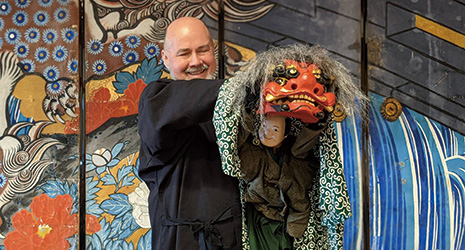
Martin Holman and puppet perform the Lion Dance 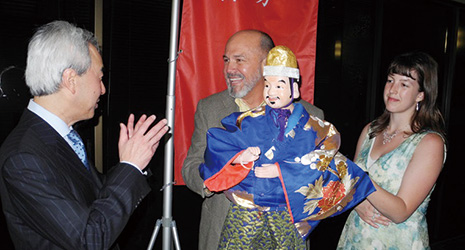
The Consul General of Japan applauds Holman following a performance at the Japan Festival in Houston, Texas, the United States in 2015
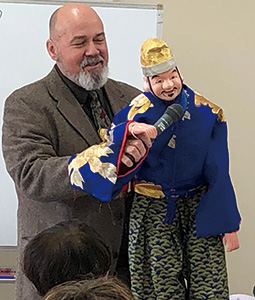
Holman gives a lecture about ningyo joruri holding the puppet for the character Ebisu used in performances of Ebisumai 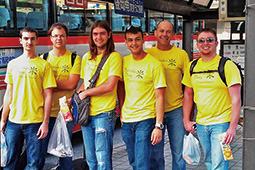
Bunraku Bay Puppet Theater members in Miyako City, Iwate Prefecture, June 2011. The puppeteers performed at kindergartens and helped with clean-up work in the area following the tsunami disaster of March the same year 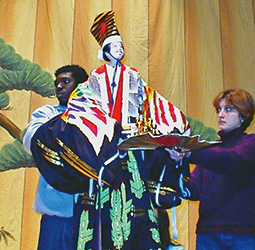
Holman’s son-in-law (left) Michael Samuel also performs ningyo joruri

American Martin Holman is the head of a traditional Japanese puppet troupe which performs ningyo joruri with members from many different countries.

Ningyo joruri is a type of traditional Japanese puppetry dating from the early seventeenth century.* One of the most active regions for this style of puppetry is Tokushima Prefecture in the eastern part of the island of Shikoku, where about twenty troupes still perform today. One of these troupes, Tokubeiza Japanese Puppet Theater, is attracting attention as a group made up of members from not only Japan, but also the United States, Mexico, New Zealand, the United Kingdom, Vietnam, Nepal and China. The group is led by American Martin Holman.
Holman, who has loved puppets since he was a child, became aware of ningyo joruri for the first time when he was a university student. “I took a class on puppet theater from around the world as a general education course, and upon seeing ningyo joruri, I was surprised to find such an amazing, sophisticated type of puppet theater. The puppets express complex emotions through subtle movements,” says Holman.
In 1978, while still a student, Holman had a chance to visit Japan for a short period, and upon doing so, he decided to pursue what he truly enjoyed for his future. When he returned home, he switched his major from biology to Japanese literature.

Later, Holman had his first hands-on encounter with ningyo joruri in 1989 as a professor, working as the head of the Japan Center for Michigan Universities, located in Hikone in Shiga Prefecture just northeast of Kyoto. Holman says, “I had known that the Tonda Traditional Puppet Theater was in the city of Nagahama, just near where I lived, so I went to watch them practice. I brazenly took a chance and told eighth-generation puppeteer Abe Hidehiko, the head of the 200-year-old troupe, that I wanted to train as a puppeteer, to which he unexpectedly responded, ‘You start tomorrow at 7:00 p.m.’” Holman then spent three years training and, in 1994, became the first non-Japanese to perform ningyo joruri on stage in Japan. After returning to the United States, he set up annual summer programs for American students from the University of Massachusetts and later the University of Missouri, where he taught Japanese language and culture, to spend 8–10 weeks receiving training in puppetry in Shiga and also in Nagano Prefecture with the 300-year-old Imada Puppet Theater and Kuroda Puppet Theater in the city of Iida. In 2004, Holman assembled some graduates of the programs to form Bunraku Bay Puppet Theater, which has performed around 200 times over the past eighteen years all over the United States, including the Kennedy Center and the Smithsonian Institution in Washington, D.C., garnering favorable reviews nationwide. Bunraku Bay’s puppetry was also featured in a short film, Kaiju Bunraku, which was selected and premiered at Sundance Film Festival in 2017.**

After retiring from the university, Holman moved to Tokushima Prefecture in 2019, where he had long wished to live for its beautiful nature and ancient puppet traditions. He now works with the Tokushima Prefectural Awa Jurobe Yashiki Museum and Theater, helping to promote the many puppet troupes in the prefecture, whose histories stretch back well over 200 years, as well as translating museum materials and puppetry scripts from Japanese to English. Holman also established his own troupe, Tokubeiza Japanese Puppet Theater, in October 2019, with members, both Japanese and non-Japanese, who perform ningyo joruri.
Their most popular piece is the Meoto Lion Dance. The festive Lion Dance is performed on New Year’s and other auspicious days. Normally, a dancer is covered with a cloth for the lion body while wearing or holding a carved lion head. In the ningyo joruri version of the Lion Dance, the puppets become the hidden dancer and the puppeteers operate the human-shaped puppet and the lion head. The lion dance puppets are heavier than the average ningyo joruri puppets, but Holman says it is worth the extra effort.

He says, “Human-interest stories*** can be very tender in their portrayal of the lives of ordinary townsfolk. And in traditional kyogen**** plays, there is a lot of humor as powerful characters are outwitted by socially weaker beings. Many old folktales, like our new project this year, Kasa Jizo, can also be performed by puppets. Anyone can enjoy these stories, from children to seniors, so I want to incorporate this kind of sensibility into our ningyo joruri, as well.”
Tokubeiza’s performances and Holman’s lectures and demonstrations on Japanese puppet theater have been somewhat limited over the past two years due to the COVID-19 situation. However, video streaming***** has led to a new challenge for Holman: to spread the beauty of ningyo joruri around the world.
* A joruri play is a musical drama expressing the characters’ personalities and emotions to the accompaniment of joruri (a generic term for storytelling in shamisen music)
** Kaiju Bunraku https://www.shortoftheweek.com/2018/06/19/kaiju-bunraku/
*** Works that show the human emotions of parent and child, married couples, and more
**** Comedy plays that humorously portray people from ordinary everyday life and from stories
***** Lion Dance Covid Strategy https://youtu.be/tg0xr-dMbik

